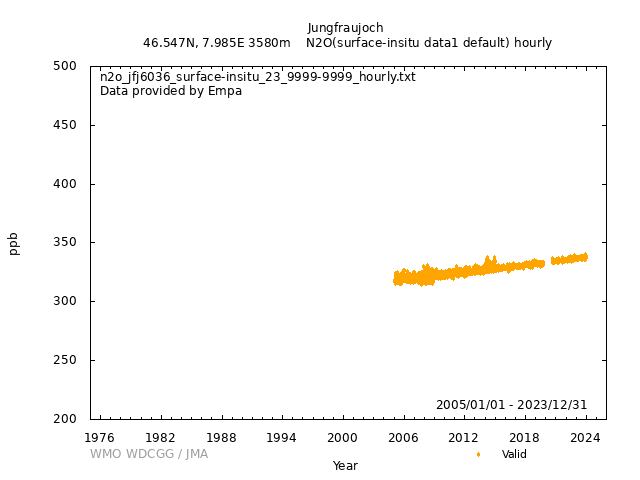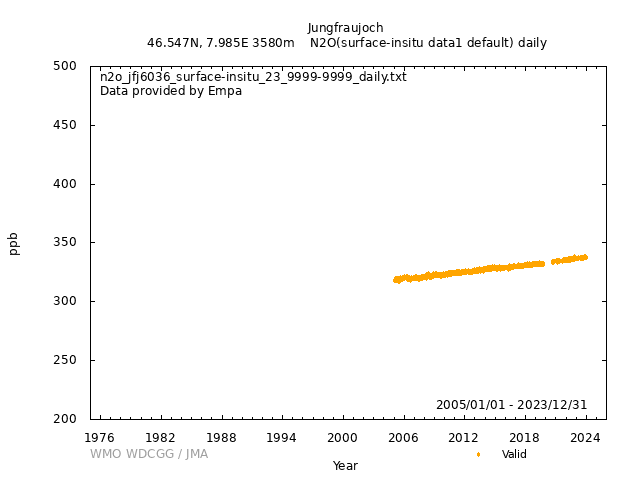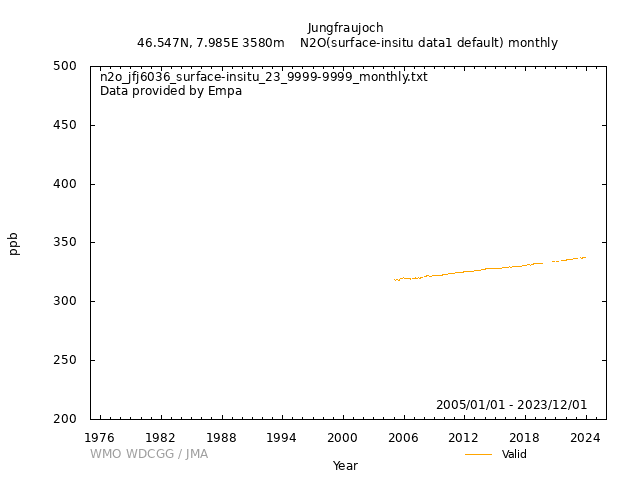Data Policy
GAW Data Policy
"For Scientific purposes, access to these data is unlimited and provided without charge.
By their use you accept that an offer of co-authorship will be made through personal contact with the data providers
or owners whenever substantial use is made of their data.
In all cases, an acknowledgement must be made to the data providers or owners and to the data centre when these data are used within a publication."
Version
2025-07-08-1503 (Last updated: 2025-07-10)File
This data set is submitted by Empa.
In line with the GAW Data Policy, users should contact the contributors of all data of interest and propose co-authorship or acknowledgement.
Organization
| NO | 23 |
|---|---|
| Acronym | Empa |
| Name | Swiss Federal Laboratories for Materials Science and Technology |
| Address 1 | Überlandstrasse 129 |
| Address 2 | 8600 Dübendorf |
| Address 3 | Switzerland |
| Country/Territory | Switzerland |
| Website | http://www.empa.ch/gaw |
Contact(s)
| Name | Martin Steinbacher |
|---|---|
| Prefix | Dr. |
| martin.steinbacher@empa.ch | |
| Organization No | 23 |
| Organization acronym | Empa |
| Organization name | Swiss Federal Laboratories for Materials Science and Technology |
| Organization country/territory | Switzerland |
| Address 1 | Ueberlandstrasse 129 |
| Address 2 | CH-8600 Duebendorf |
| Address 3 | Switzerland |
| Country/territory | Switzerland |
| Tel | +41 58 765 4048 |
| Fax | |
| Last updated date | 2025-10-02 |
| Background observation | |
| UTC+01:00 | |
| ppb | |
|
2005-01-01 00:00:00 - 2012-03-31 23:59:59: SIO-98 2012-04-01 00:00:00 - 9999-12-31 23:59:59: WMO N2O X2006A |
|
|
2005-01-01 00:00:00 - 2014-12-31 23:59:59: Agilent 6890(Gas chromatography (ECD)) 2015-01-01 00:00:00 - 2020-07-31 23:59:59: Los Gatos Research, LGR N2O-CO_23r, S/N 12-0066(off-axis integrated cavity output spectroscopy (OA-ICOS)) 2020-08-01 00:00:00 - 9999-12-31 23:59:59: Picarro Inc, G5310, S/N JKADS5106(CRDS) |
|
|
9999-12-31 00:00:00 - 9999-12-31 23:59:59: 10 (m) |
|
| 5 seconds | |
|
GC-ECD: every 24min (alternating with air samples) before December 2008: every 30min (alternating with air samples) Data are corrected for detector non-linearity. OA-ICOS: We use a modified multi inlet unit from LGR, controlled by LGR’s gas manifold control software which is part of the instrument control and data recording programme. Flows for reference gases are set with individual needle valves for each port. Modifications of the inlet unit comprised the installation of an additional normally open solenoid valve that is hard-wired with solenoid valve for the ambient air port1, i.e. each time the ambient air port is activated, the normally open solenoid valve closes and ambient air can be drawn through the multi inlet unit into the LGR; when other ports are selected the additional valve remains open and allows an overflow and thus, the sampling of calibration gas is under ambient pressure conditions. CRDS: We use a custom-built calibration unit with a solenoid valve to either select ambient air or gas from a reference tank. The reference tank is selected by means of a multi-position rotary valve. Valves are controlled by the software of the instrument. Flows for reference gases are controlled by a mass-flow-controller. A vent is implemented in the plumbing path for the reference gases, thus, the sampling of calibration gas is under ambient pressure conditions. A Nafion dryer is used for sample drying. -- Scale and Calibration (traceability): GC: Each ambient air sample is bracketed with calibration runs, using real-air standards (working standards) with concentrations representative for Northern Hemisphere tropospheric concentrations. OA-ICOS: A working tank is measured every 3 hours for 20 min to account for short-term sensitivity changes. A target gas is measured every 16 hours, a 3-point calibration is performed every 33 hours. Target and calibration gases are measured for 25min; the first 10min are rejected (to allow sufficient time for signal stabilization) for calculating the measured values. CRDS: A working tank is measured once a day to account for short-term sensitivity changes. One target gas is measured twice a day, another target tank once a week. A 3-point calibration is performed every 3 days. Working, target and calibration gases are measured for 30min; the first 20min are rejected (to allow sufficient time for signal stabilization) for calculating the measured values. -- Several long-term comparisons haven shown a good agreement of the SIO-98 and WMO X2006A scales within the uncertainty of the observations (see e.g. https://www.wmo.int/pages/prog/arep/gaw/documents/GGMT2015_T21_Krummel.pdf). The GC-ECD data are not reported anymore. However, the GC-ECD ran next to the OA-ICOS analyzer until summer 2016 and regular comparisons of the side-by-side observations were performed for quality control. A very good agreement between the two techniques for the one-year overlap period is observed. September 2018 onwards: reference gases are prepared and analyzed by ICOS Central Calibration Laboratory in Jena, Germany; gases are fully traceable to WMO X2006A. |
|
|
Quality assurance procedures involve time series plots, consistency checks. Since 2020 (when measurement technique was changed from OA-ICOS to CRDS), raw data are sent daily to the Atmospheric Thematic Centre (ATC) of the Integrated Carbon Observation System (ICOS) Research Infrastructure at LSCE in France (see https://icos-atc.lsce.ipsl.fr/). See Hazan et al. (2016) for details about the data processing. Screening and flagging of the data is made by Empa staff on an ATC server; 1-min data are extracted from the server, and aggregates are calculated by Empa prior to submission to WDCGG (see also "Processing for averaging" section). Time stamps are converted from UTC to local winter time (UTC"1) for consistency reason as earlier data were also reported in UTC+1. |
|
|
[Hourly] GC-ECD, 2005-2014: number of detections refers to the number of individual injections within the respective hour. OA-ICOS & CRDS, 2015 - 2019 (OA-ICOS), from 2020 onwards (CRDS): number of detections refers to the number of available 1-minute averages within the respective hour; data are discarded when less than 15 1-min averages are available for the respective hour [Daily] GC-ECD, 2005-2014: number of detections refers to the number of individual injections within the respective day. OA-ICOS & CRDS, 2015 - 2019 (OA-ICOS), from 2020 onwards (CRDS): number of detections refers to the number of available hourly averages within the respective day; data are discarded when less than 12 hourly averages are available for the respective day [Monthly] GC-ECD, 2005-2014: number of detections refers to the number of individual injections within the respective month. OA-ICOS & CRDS, 2015 - 2019 (OA-ICOS), from 2020 onwards (CRDS): number of detections refers to the number of available daily averages within the respective month; data are discarded when less than 10 daily averages are available for the respective month |
|
| Operational/Reporting | |
|
Sampling Environment : measurements in pristine air, usually negligible local sources. Surfaces are mostly covered by snow or ice apart from some steep slopes of bare rock. No vegetation or soil present in the vicinity. Air intake : open-face ambient Sampling and Analysis Frequency : 2005-2014 (GC-ECD): 24min (30min before December 2008) 2015 and onwards (OA-ICOS): continuous Description of Instruments : GC-ECD: Two Hayesep Q columns are applied for the separation of N2O and SF6. The carrier gas is 5% CH4, in Argon treated with a high capacity gas purifier (Supel-co). CH4, quality 4.5 in Argon, quality 5.0 was used until summer 2008, followed by CH4, quality 5.5 in Argon, quality 6.0. No significant change in measurement performance was observed after the change of the carrier gas quality. However, better quality carrier gas was chosen to exclude po-tential artefacts due to impurities in the carrier gas. A 10-port gas selector valve allows to alternately measure ambient air and standard samples. The ambient air is supplied to the instrument through stainless steel tubings (1/8” OD) by means of a pump (KNF Neuberger) with a flow rate of approximately 1 l min-1. A pressure relief valve releases the excess air right in front of the gas selector valve as the flow through the sampling loops is con-trolled to 40 ml/min using a mass flow controller (Bronkhorst) located downstream of the sample loops. The loops are mounted in a thermally insulated housing to minimize temperature fluctuations. All samples (ambient air as well as the standards) are passing a Nafion drier tube mounted between the gas selector valve and the sample loops. Dry zero air for the Nafion counterflow is taken from a TOC pure air generator (Whatman, Parker Hannifin) passing an additional cartridge with Rubingel. One measurement sequence takes 15 (later set to 12) minutes. The loops are flushed for two minutes before switching the gas selector valve to an off-position and waiting 65 seconds for equi-libration, followed by the injection of the sample volume onto the columns. After the gases of inter-est passed the pre-columns, the pre-columns are backflushed to avoid interferences of slowly passing species. The system is fully automated and controlled by the GCwerks software (http://gcwerks.com/). OA-ICOS: The off-axis integrated cavity output spectrometer (OA-ICOS) from Los Gatos Research Inc. uses a quantum cascade laser as mid-infrared laser source. Raw data are stored as 5-sec averages. CRDS: The G5310 N2O/CO analyzer from Picarro uses Cavity Ringdown Spectroscopy in the mid-infrared. Raw data are sent daily to the ICOS Atmospheric Thematic Centre at LSCE in France for data processing. See Hazan et al., AMT, 2016 for details on the data processing. Samples are dried with a Nafion dryer. |
|
|
Wind direction: 1 Wind speed: 1 Relative humidity: 1 Precipitation amount: 0 Air pressure: 1 Air temperature: 1 Dew point temperature: 0 Sea water temperature: 0 Sea surface water temperature: 0 Sea water salinity: 0 Sea surface water salinity: 0 |
|
|
Meteorological data may remain as first provided, even when greenhouse gas data are updated. Meteorological data at Jungfraujoch are measured by MeteoSwiss as part of its operation of the SwissMetNet Network. see www.meteoswiss.admin.ch/ and Appenzeller et al., Monitoring climate at Jungfraujoch in the high Swiss Alpine region, Science of The Total Environment, 391 (2-3), 262-268, https://doi.org/10.1016/j.scitotenv.2007.10.005 for more information. |
DOI Metadata
| DOI |
|
||||||||||||||||
|---|---|---|---|---|---|---|---|---|---|---|---|---|---|---|---|---|---|
| Version |
2025-07-08-1503 (Data Version History) * DOIs and file names may have multiple versions. Be sure to check the data version. |
||||||||||||||||
| Title | Atmospheric N2O at Jungfraujoch by Swiss Federal Laboratories for Materials Science and Technology, dataset published as N2O_JFJ6036_surface-insitu_Empa_data1 at WDCGG | ||||||||||||||||
| Creator |
Swiss Federal Laboratories for Materials Science and Technology Martin Steinbacher (Empa) |
||||||||||||||||
| Publisher | World Data Centre for Greenhouse Gases | ||||||||||||||||
| Publication Date | 2018-07-06 (Last Updated: 2025-07-10) | ||||||||||||||||
| Format | Text (WDCGG Data Format Table, WDCGG Meteorological Data Format Table), NetCDF | ||||||||||||||||
| Relation List (Is Part Of) |
All N2O data contributed to WDCGG by GAW stations and mobiles by 2025-09-17 All N2O data contributed to WDCGG by GAW stations and mobiles by 2024-09-24 All N2O data contributed to WDCGG by GAW stations and mobiles by 2023-09-13 All N2O data contributed to WDCGG by GAW stations and mobiles by 2022-09-05 All N2O data contributed to WDCGG by GAW stations and mobiles by 2021-08-24 All N2O data contributed to WDCGG by GAW stations and mobiles by 2020-09-28 All N2O data contributed to WDCGG by GAW stations and mobiles by 2019-09-19 All N2O data contributed to WDCGG by GAW stations and mobiles by 2018-10-23 |
||||||||||||||||
| Geolocation Point |
|
GAW Data Policy
"For Scientific purposes, access to these data is unlimited and provided without charge.
By their use you accept that an offer of co-authorship will be made through personal contact with the data providers
or owners whenever substantial use is made of their data.
In all cases, an acknowledgement must be made to the data providers or owners and to the data centre when these data are used within a publication."
Citation format
This format is an example of the WDCGG standard citation.
Please follow the citation format which the data providers or owners indicate.
Please follow the citation format which the data providers or owners indicate.
Martin Steinbacher (Empa),
Atmospheric N2O
at Jungfraujoch by Swiss Federal Laboratories for Materials Science and Technology,
dataset published as N2O_JFJ6036_surface-insitu_Empa_data1 at WDCGG,
ver. 2025-07-08-1503, https://doi.org/10.50849/WDCGG_0023-6036-1003-01-01-9999 (Reference date*: YYYY/MM/DD)
* As the reference date, please indicate the date you downloaded the files.
* As the reference date, please indicate the date you downloaded the files.
Reference(s)
| 1 | Hazan, L., Tarniewicz, J., Ramonet, M., Laurent, O., and Abbaris, A.: Automatic processing of atmospheric CO2 and CH4 mole fractions at the ICOS Atmosphere Thematic Centre, Atmos. Meas. Tech., 9, 4719–4736, https://doi.org/10.5194/amt-9-4719-2016, 2016. |
|---|---|
| 2 | Yu L., E. Harris, S. Henne, S. Eggleston, M. Steinbacher, L. Emmenegger, C. Zellweger, J. Mohn, 2020 - The isotopic composition of atmospheric nitrous oxide observed at the high-altitude research station Jungfraujoch, Switzerland, Atmospheric Chemistry and Physics, 20, 6495-6519, https://doi.org/10.5194/acp-20-6495-2020. |






